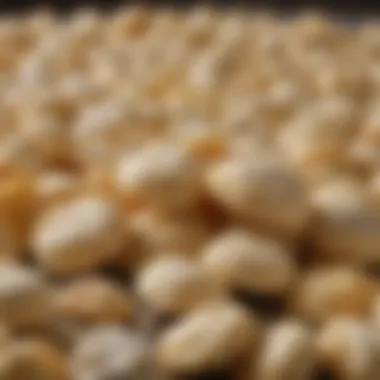Individual Oyster Cracker Packets: All You Need to Know


Intro
Individual oyster cracker packets are an often-overlooked element in various culinary contexts yet serve as notable accompaniments. These small, crisp crackers bring texture and flavor to soups, salads, and snacks, enhancing the overall dining experience. This guide sheds light on their history, production processes, and culinary applications, underscoring their significance in modern cuisine.
Not just a filler, oyster crackers have a rich background, rooted in coastal dining traditions. They add not only an appealing crunch but also absorb flavors without overpowering the main dishes. This makes them versatile in many culinary settings.
In the following sections, we will explore a comprehensive overview of oyster cracker packets, their ingredients, and some creative ways they can be utilized. Let us dive into the details that make them so compelling.
Understanding Individual Oyster Crackers
Understanding individual oyster crackers is essential for several reasons. They serve as a common accompaniment to many dishes, such as soups and salads, enhancing the eating experience. By examining their characteristics and historical relevance, one gains insight into both culinary practices and consumer preferences.
Defining Oyster Crackers
Oyster crackers are small, crunchy, and typically circular in shape. They have a mild flavor, which makes them versatile in various culinary contexts. Made primarily from flour, leavening agents, and a few other ingredients, their light texture complements soups, especially clam chowder. Their name derives from their traditional pairing with oyster stew, thus connecting them to seafood and coastal cuisines.
Historical Context
The origins of oyster crackers trace back to the 19th century. Initially popularized in coastal New England, they became staples in restaurants serving seafood dishes. The evolution of oyster crackers reflects broader trends in food preservation and convenience. Packaged oyster crackers gained traction after World War II, as more people sought easy-to-prepare meals. As they became widely available, they cemented their place in American dining culture, particularly as a comforting addition to soups.
Culinary Significance
Culinary significance of oyster crackers can be attributed to their adaptability. They are not just limited to soups; they also enhance salads and can be served as a standalone snack. Their neutral taste allows chefs to play with flavors, adding spices or toppings. Additionally, they have nutritional aspects. Although they are primarily carbs, their role in meals often helps with portion control. Understanding their culinary significance goes beyond taste; it's about how they create flavor balance in various dishes.
"Oyster crackers are more than mere accompaniments; they represent a culinary tradition that bridges various dining experiences."
Production of Oyster Crackers
The production of oyster crackers is a critical topic in understanding their role in the culinary world. This process not only involves the selection of quality ingredients but also detailed manufacturing techniques that ensure the unique texture and flavor of these snacks. By comprehending the production steps, one can appreciate the craftsmanship that goes into creating each individual oyster cracker packet. This knowledge is vital for food enthusiasts who seek to explore the origins and quality of what they consume.
Ingredients Overview
The cornerstone of any successful production process is the selection of the right ingredients. For oyster crackers, the primary components typically include:
- Wheat Flour: Acts as the main structure, providing a base for the crackers' texture.
- Cornstarch: Adds lightness and helps achieve the desired crunchiness.
- Baking Powder: Functions as a leavening agent, allowing the crackers to expand as they bake.
- Salt: Enhances flavor, making the crackers more palatable.
- Water: Binds the dry ingredients together, influencing the dough’s consistency.
These ingredients combine to form a dough that, when properly mixed and kneaded, yields a robust cracker once baked. Variations may occur depending on the brand but generally adhere to this foundational blend.
Manufacturing Process
The manufacturing process of oyster crackers consists of several key stages that ensure consistency and quality. This process can be broadly outlined as follows:
- Mixing: The ingredients are combined in large mixers. Precision in measurement is crucial, as slight deviations can affect taste and texture.
- Kneading: After mixing, the dough is kneaded. This step develops gluten, which contributes to the cracker's structure and chewiness.
- Rolling: The kneaded dough is rolled out to a uniform thickness. This prepares the dough for cutting and ensures even baking.
- Cutting: The rolled dough is then cut into small shapes, usually squares, characteristic of oyster crackers. This step is usually mechanized to maintain consistency.
- Baking: The cut pieces are baked in large ovens. The baking time and temperature are carefully controlled to achieve the right crunch without burning.
- Cooling and Packaging: After baking, the crackers are cooled before being packaged into individual servings or larger bulk bags to ensure freshness.


Understanding this production process sheds light on why oyster crackers are such a staple accompaniment in various dishes. The attention to detail in ingredient selection and manufacturing not only yields a product that pairs beautifully with soups and salads, but also one that stands up to consumer expectations for taste and quality.
Packaging Routes
Packaging routes encompass the various methods and strategies used to package individual oyster crackers in a way that caters to both manufacturers and consumers. This aspect is not only about the physical appearance of the packages but also about functionality, sustainability, and market appeal. As consumers demand more convenient, single-serving options, individual oyster cracker packets have risen in popularity. They serve practical purposes, such as portion control and ease of use, while also engaging the consumer's attention with appealing packaging designs.
Benefits of Individual Packets
Individual packs of oyster crackers offer multiple advantages:
- Portion Control: Each packet contains a specific amount, allowing consumers to manage their serving sizes easily.
- Convenience: These packets are portable and easy to store, making them ideal for restaurants, picnics, or quick snacks at home.
- Freshness Preservation: Sealed packets help maintain the freshness and taste of the crackers, extending their shelf life compared to bulk packaging.
- Hygienic: Single-serve packets reduce the risk of contamination and promote food safety.
Sustainability Considerations
Sustainability is a growing concern across industries, and packaging for oyster crackers is no exception. Here are some points to consider:
- Material Choice: Using eco-friendly materials such as biodegradable or recyclable films can reduce the environmental impact of packaging.
- Waste Reduction: Smaller packaging sizes can lead to less material waste, benefiting the environment when designed thoughtfully.
- Consumer Demand: Increasingly, more consumers prefer products that align with sustainable practices. This trend influences brands to adopt better packaging solutions.
"The move towards sustainable packaging solutions reflects a larger shift in consumer attitudes towards environmental responsibility."
Consumer Preferences
Understanding consumer preferences is crucial for the success of individual oyster cracker packaging. Key insights include:
- Visual Appeal: Attractive designs can draw consumers' attention, making them more likely to purchase a product.
- Transparency in Ingredients: Consumers appreciate knowing what they are eating, so clear labeling and ingredient lists can enhance trust and attract health-conscious buyers.
- Variety Availability: Offering multiple flavors or styles in individually packaged formats can cater to diverse tastes, enhancing the marketability of the product.
- Cultural Relevance: Packaging that resonates with specific cultural contexts or culinary traditions can create stronger connections with consumers.
Through mindful packaging strategies, individual oyster cracker packets can meet consumer demand for convenience and sustainability while ensuring their market presence remains strong.
Culinary Applications
Understanding the culinary applications of individual oyster cracker packets is vital for appreciating their versatility. These crisp, bite-sized crackers serve as more than mere accompaniments to soups and stews; they play an integral role in enhancing flavors and textures across a variety of dishes. Their lightness offers a contrast to richer flavors found in many recipes. This section explores different ways to use oyster crackers across various culinary contexts.
Pairing with Soups and Stews
Oyster crackers are inherently designed to complement soups and stews. Their crunch adds a pleasant texture that balances the moisture of these dishes. Traditionally, oyster crackers are small and light, making them easy to sprinkle atop creamy chowders or brothy soups. When dipped into a warm stew, they absorb some liquid while retaining their crispiness. This ability to adapt makes them a preferred choice in many regions.
Furthermore, various regional soups commonly use oyster crackers. For instance, in New England, they are often served with clam chowder, while in the southern United States, they accompany gumbo. The neutrality of flavor allows them to pair well with both delicate and robustly seasoned dishes. Here are a few key points regarding their pairing:
- Texture Contrast: They provide an enjoyable crunch, enhancing the overall eating experience.
- Absorption: Their ability to absorb broth without becoming mushy contributes to dish consistency.
- Visual Appeal: Small crackers add elegance and appeal when sprinkled over soups.
Enhancing Salads and Snacks
Oyster crackers can transform salads and snacks significantly. They offer a playful crunch that elevates ordinary mixed salads to a new level. For example, incorporating them into a Caesar salad adds an unexpected textural component. Recipes like oyster cracker salad mixes often combine seasonings and dressings to create unique flavored crackers, which then serve as a salad topping. This flexibility makes them valuable as a versatile ingredient.
For snacks, oyster crackers can be seasoned and baked or fried, providing a delightful crunchy treat. Here are some ideas:


- Oyster Cracker Trail Mix: Combine with nuts and dried fruits for a quick snack.
- Savory Seasoned Crackers: Toss with oil and seasoning, then bake for flavorful snacking.
- Crunchy Salad Topper: Sprinkle over a fresh salad to add texture and intrigue.
Innovative Uses in Recipes
The ingenuity of oyster cracker use extends beyond traditional pairings. Creative culinary minds are incorporating them into various recipes, pushing boundaries in flavor combinations. Recipes like oyster cracker crusted chicken or as binders in casseroles showcase their potential for innovation.
They serve as an unexpected ingredient in gourmet dishes, often found in upscale restaurants or unique food trucks. Here are some inventive applications:
- Casserole Binder: Use crushed oyster crackers to create a crunchy topping for casseroles.
- Cracker-Crusted Proteins: Mix crushed oyster crackers with herbs and spices to coat fish or chicken.
- Soup Alterations: Experiment with different flavors, such as cheddar cheese or garlic-oil, to create gourmet soups.
By leveraging the versatility of oyster crackers, culinary enthusiasts can create dishes that surprise and satisfy. Their adaptability allows for endless creativity in the kitchen.
By recognizing these culinary applications, one can understand the myriad ways individual oyster cracker packets enhance dishes. Their role is often understated but undeniably impactful in broadening flavor profiles and improving overall dining experiences.
Market Analysis
The topic of market analysis is crucial in understanding the dynamics surrounding individual oyster cracker packets. This part of the article will explore how consumer preferences shape demand and the competitive landscape of the market. By focusing on these elements, readers can grasp the significance of market trends and their implications for both consumers and manufacturers.
Consumer Trends
In recent years, consumer habits have shifted significantly, with individuals increasingly seeking snacks and accompaniments that align with their tastes, dietary preferences, and lifestyles. Oyster crackers are witnessing a resurgence due to several factors:
- Health Consciousness: As consumers become more aware of nutritional content, there is a growing preference for snacks that offer lower caloric intake. Individual oyster cracker packets present a portion-controlled option that is appealing for calorie-conscious individuals.
- Convenience: The demand for grab-and-go snacks has never been higher. Individual packets cater to this need, making it easy for consumers to incorporate oyster crackers into their meal routines, whether at home or on the move.
- Variety Seeking: There is a noticeable trend toward exploring different flavors and textures. While traditional oyster crackers have a loyal following, many consumers are open to trying innovative flavors, which manufacturers are beginning to introduce into the market.
These trends reveal a growing interest among consumers for individual oyster cracker packets as part of their snacking habits. Understanding these behaviors can help manufacturers align their products with consumer expectations and needs.
Competitive Landscape
The competitive landscape of the oyster cracker market is characterized by several key players, both large and small. Though the market is relatively niche, there are notable factors at play:
- Brand Recognition and Loyalty: Established brands like Carr's and Keebler maintain a strong presence in the market, benefiting from brand loyalty. These brands offer trusted products, reinforcing consumer trust.
- Emerging Brands: New entrants are also gaining attention. Small, artisanal producers are beginning to supply gourmet variants of oyster crackers. They appeal to consumers looking for high-quality, unique options, contributing to a more diverse market.
- Innovation in Products: The competitive environment fosters innovation, as brands strive to differentiate themselves through unique flavors, packaging styles, or health-focused formulations. The ability to adapt to changing trends is vital for maintaining relevance in this sector.
Understanding the competitive landscape allows potential market entrants to identify opportunities and threats. By recognizing what leading brands do well and where gaps exist, new manufacturers can effectively position themselves.
Ultimately, market analysis serves as a foundational element in the oyster cracker industry's success, showcasing how consumer behaviors impact production and competition. By staying informed on trends, stakeholders can make strategic decisions that align with evolving consumer demands and industry standards.
Nutritional Aspects
Understanding the nutritional aspects of individual oyster cracker packets is crucial for both consumers and culinary professionals. Nutritionally, these crackers may serve as a simple yet significant addition to meals. They can complement many dishes and provide texture alongside various nutrients. This section will discuss the caloric content, the ingredients commonly used, and possible allergenic reactions associated with individual oyster crackers.
Caloric Content and Ingredients
Individual oyster crackers have a generally modest caloric profile. A typical serving contains approximately 60 to 70 calories. These crackers primarily consist of basic ingredients such as wheat flour, vegetable oil, salt, and leavening agents. The simplicity of the ingredients resonates with many who seek convenient yet unprocessed options in their diets.


- Wheat Flour: This is the main component and is rich in carbohydrates.
- Vegetable Oil: Often included to create a desirable texture.
- Salt: Adds flavor but can be a consideration for those monitoring sodium intake.
- Other Additives: Some brands may include spices or flavor enhancers, which can alter the nutritional profile.
It is important to read labels and consider the ingredients involved. While the caloric amount is low, the nutritional value can vary significantly depending on the specific brand and its recipe.
Potential Allergenic Reactions
In terms of allergens, oyster crackers can pose risks for certain individuals. The key allergenic ingredients often include wheat, which could trigger reactions in those with gluten sensitivities or celiac disease.
Other potential allergens include:
- Sesame Seeds: Sometimes used in certain recipes.
- Soy: Some commercially produced options may include soy derivatives.
- Dairy: Though rare, some brands might add dairy products or flavorings.
To mitigate risks, always check the packaging. Consumers with specific allergies need to be cautious, as cross-contamination during manufacturing is also a concern.
For many, being aware of what goes into their food is essential, especially when allergens are involved.
Cultural Impact
The cultural significance of individual oyster cracker packets cannot be overstated. These small, yet impactful, accompaniments resonate deeply within American culinary traditions. They are not merely snacks; they embody regional flavors and familial memories. Understanding their role highlights how food items such as oyster crackers can contribute to shared experiences within communities.
Regional Preferences
The preferences for oyster crackers can vary significantly across different regions of the United States. For instance, in New England, these crackers are commonly served alongside clam chowder, symbolizing warmth and comfort. Alternatively, in the Midwestern states, they often accompany hearty dishes like chili. This discrepancy showcases the versatility of oyster crackers, adapting to local tastes while still maintaining their core essence.
In some areas, you might find oyster crackers that are seasoned differently, reflecting the local cuisine. In Louisiana, for example, they may often feature a bit of Cajun spice, enhancing their flavor to match the zesty local food.
Traditions Involving Oyster Crackers
Traditions surrounding oyster crackers often emerge during family gatherings and festive occasions. Many families have their own rituals that involve these small goodies. It is common, for instance, for people to bring a few packets to potluck dinners, ensuring everyone has a crunchy addition to their meal. These behaviors foster a sense of community and nostalgia, reinforcing family bonds.
"Food is a part of the world and a part of life. It brings people together in so many ways."
In some cultural contexts, oyster crackers are also a staple at sporting events. Fans enjoy them while they cheer on their teams, turning snacks into a part of the game-day festivities.
Overall, the cultural impact of individual oyster cracker packets is intricate. They serve as a bridge between generations and communities, enhancing culinary experiences in a way that many might not fully appreciate.
Future Innovations
The landscape of individual oyster cracker packets is evolving, influenced by changing consumer preferences and technological advancements. This section explores emerging trends and potential developments in the market. Keeping an eye on future innovations is vital, as they can enhance both the sustainability and culinary experience of these crackers.
Potential Market Developments
Market developments play a crucial role in the wider acceptance and integration of oyster crackers into various cuisines.
- Health-Conscious Products: With increasing consumer emphasis on health, brands might introduce versions of oyster crackers using whole grains or alternative flours. This could cater to gluten-free or low-carb diets, attracting a broader audience.
- Packaged Comfort: Individual packaging remains appealing. However, businesses could innovate by integrating resealable options. This would address convenience, allowing consumers to enjoy fresh crackers over time.
- Eco-Friendly Packaging: Sustainability is becoming more critical. Future market strategies might include biodegradable or compostable materials in individual packaging. This shift aligns well with modern environmental concerns.
- Collaborations with Restaurants: Partnerships with restaurants may introduce exclusive flavors or branded partners. This dynamic could bring new life to the classic cracker while driving brand awareness.
Evolution of Flavors and Varieties
Diversity in flavor and form is essential to keep the product relevant. Consumers now desire more than just the traditional oyster cracker taste.
- Variety in Flavors: Expanding beyond basic flavors could be a game changer. Options like garlic, cheese, or spicy blends can appeal to adventurous eaters. Special limited editions could also create buzz.
- Cultural Influences: As globalization increases, so do multicultural influences in food. Integrating flavors inspired by various cuisines may capture interest. For instance, a soy sauce-flavored cracker could resonate with those who enjoy Asian cuisine.
- Seasonal Specials: Seasonal varieties, such as pumpkin spice in fall or cranberry in winter, could create a sense of anticipation and exclusivity for consumers.
- Health-Enhanced Options: Innovations could lead to oyster crackers fortified with vitamins, minerals, or probiotics. This approach offers consumers a guilt-free snack while emphasizing health benefits.







